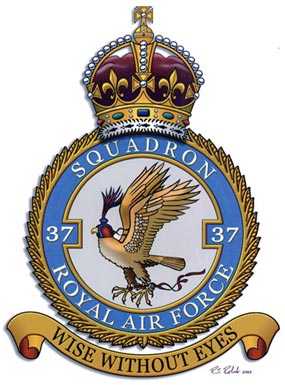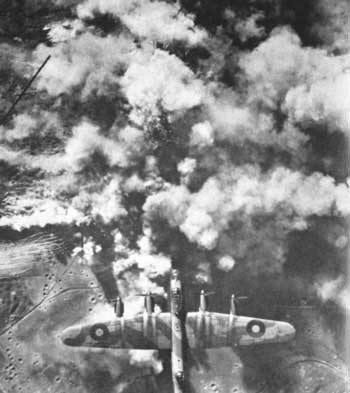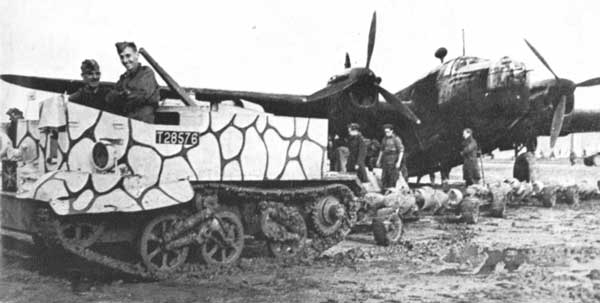
An Army Bren gun carrier brings trolley loads of
bombs to a Wellington Mk.II at Luqa, Malta, 1942.
A Tour of Duty
Once on an operational Squadron, a tour of duty was 40 completed operations. An "op" was a successfully completed flight or sortie, where the primary or secondary target had been attacked. Crews turning back early through technical problems did not count as having successfully operated. The loss rate was around the 4 to 5 percent mark, so mathematically it was impossible to survive. Yet about 35 percent of crews survived a first tour, after which they were classed as "tour expired" or "screened", then usually trained as instructors and sent to HCUs (Heavy Conversion Units) and OTUs (Operational Training Units) to train more crews. After a six month rest, they came back for another tour of 20 operations. If they survived this, they could volunteer for more but if they chose not to they remained as instructors unless promoted to higher things.
During the first five operations a new crew was ten times more likely to not return from an operation due to lack of experience. Once a crew survived 20 ops, the odds were thought to be about even.
Aircrew in Squadrons based in England were often able to take leave during a tour of duty. In many squadrons the rule was "no leave until 5 operations are complete", but normally aircrew received one week's leave every six weeks. Most airmen went "home" to wives or parents and it was nothing unusual for a son or husband to turn up at little or no notice with a crewmate or two along, especially if these were Canadians or Australians, sampling British home life.
Crews on Squadrons based outside of England were not so fortunate. The crews were generally granted a one week rest period in the middle of their tour of operations. The week would usually be spent at a local resort or hotel that had been commandeered by RAF specifically for the use of aircrew stationed nearby.
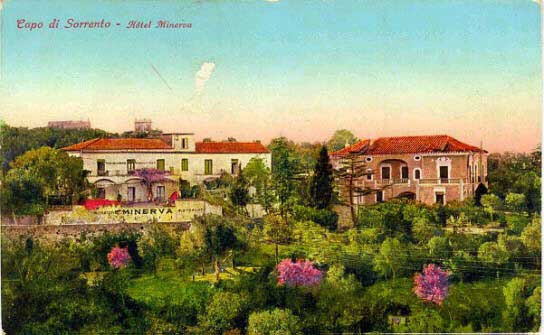
A postcard from the Hotel Minerva - RAF rest camp
near the beach in Sorrento, Italy.
Aircrew of 37 Squadron in Italy stayed here for a week during their "rest
period" while on a tour of ops.
The bomber offensive progressed at such a rate that any period of time away from operations could leave aircrew thoroughly out of date with their knowledge and techniques. A return to operations after a six month break was traumatic, and a great number of crews were lost at the beginning of a second tour. Still, most aircrew found the dull and repetitive life of flying at training units so boring after squadron life that that they usually pulled whatever strings they could to return to operations.
Many of the men, doing a second tour with a different crew than their first, would find that they had finished a tour before the rest of the crew. Such was the comradeship of these crews that most would volunteer to do a few extra so that the crew's unity was preserved. Others thought it would be foolish to push their luck, and would that they be "tour expired" after the proper number of operations. There were many cases of a man doing one extra operation as a favor to their crew, or a tour-expired crew stepping in to make up the numbers, and then failing to return.
Bomber crews had a ten percent chance of baling out after being shot down. The German anti-aircraft system was extremely well organized. The Luftwaffe's night fighter force was also very highly developed, with ground radar stations directing airborne radar-equipped night fighters into the bomber stream. High-flying Luftwaffe aircraft dropped flares to mark the bomber stream's progress.
Firepower
The .303 inch caliber machine guns of the RAF air-gunners were outgunned by the 20mm and 30mm cannon carried by the Luftwaffe. The RAF air-gunners would not open fire unless attacked by a night-fighter - their guns were defensive. Although the .303's rate of fire was 12 rounds per second, and its effective range reckoned to be 400 yards, at night if within visible range, the night-fighters were also within range of the .303s.
Mid-upper and rear-gunners were isolated from their crewmates except via intercom and had to stay alert for long periods in subzero temperatures. Their fields of fire overlapped somewhat; the mid-upper could rotate through 360 degrees. They could call for a corkscrew (violent evasive action) at a moment's notice. The trick was to take evasive action inside the attacking curve of the fighter, forcing him to steepen his turn in order to be able to shoot into the space where the bomber was expected to be by the time the bullets and shells arrived. Dive port, climb port, roll, dive starboard, climb starboard, roll ... and good air-gunners, knowing what was happening next, could fire into the space where they expected the night fighter to be.
Few night fighter crews persevered with an attack after the bomber had spotted them, and fewer still night fighter pilots had the skill to stay with a corkscrewing bomber and shoot it down as they flew together. A determined and experienced bomber pilot could make the evasive maneuver so violent that rivets popped out of the aircraft.
The Luftwaffe soon developed the "Schrage Musik" upward-firing cannon fitted to some Me110 and Ju88 night fighters. Attacked from directly below, many heavies were lost, and it was not until bombers returned with vertically pierced damage that the new threat was realized. This technique was so effective that night fighter pilots would not shoot directly into a bomber's fuselage for fear the bomb load would explode immediately above, destroying both aircraft. Instead, they tried to aim at the wing in hopes of hitting the fuel tanks and engines.
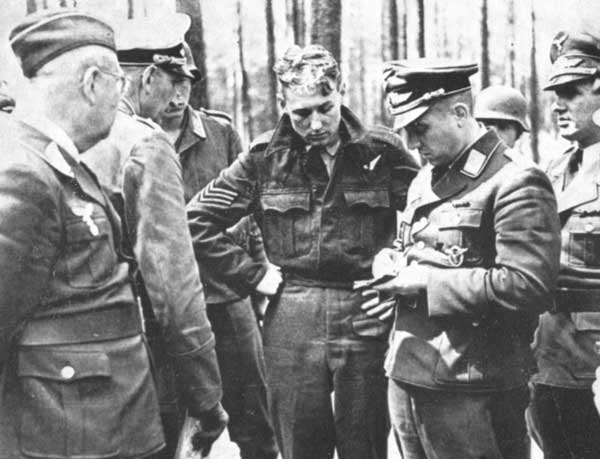
An RAF bombers Air Gunner is interrogated by Germans after being shot down over
Berlin.
Gadgets and inventions
Many new electronic devices came into service. "Gee" was a radio navigation system with three transmitters in England sending a synchronized radio pulse at precise intervals. By comparing the slight time difference of arrival time of each pulse, navigators could check a chart and calculate their position very accurately. It did not extend over the radio horizon, and the Germans soon started to jam it, but it was very effective over the UK and the North Sea. Modern day developments of Gee's radio triangulation system are still in use today in the form of the Global Positioning Satellite system. The principle - TDOA or Time Difference of Arrival - is very similar to the wartime Gee.
"H2S" was a downwards pointing radar scanner in the rear belly of the aircraft; a large perspex black-painted blister contained the rotating scanner. It gave a reasonable "picture" of the ground below - water, buildings and roads showed up clearly. It could not be jammed, but specially-equipped Luftwaffe night-fighters could home in on any aircraft using it. Once this was known, H2S was only used by a bomber for very short periods. The popular explanation for the strange name of "H2S" is that a high ranking Air Staff officer was visiting the factory where the units were being built. On being told of the device's expected performance he was openly skeptical. "It stinks", he said bluntly, "call it H2S" [hydrogen sulphide - the smell of rotten-eggs].

The area south-west of Swinemunde on the Baltic coast displayed (right) on the
screen of an H2S set inside a bomber.
Note by comparison with map (left) how land shows up lighter than water.
These devices and vastly improved training for aircrew - especially navigators - brought about a dramatic increase in bombing accuracy. Still operating by night, RAF Bomber Command could now find their targets, which were by this time very often city centers as well as strategic and tactical military targets.
Strategy
In the early days, pilots were given a main target, a couple of alternates, and left to plan their own take-off times and routes based on their own experience and preferences, but within a year the defenses were sharpening and it was necessary to co-ordinate tactics, not just for pilots in one squadron, but for the entire Bomber Force.
By mid 1941 it was possible to send many hundreds of medium and the first of the heavy bombers together in large numbers while briefing the crews to attack over a short time period. This swamped the defenses and decreased losses. But RAF Bomber Command's accuracy was still not good enough and the Command was losing prestige. Its new Commander in Chief, Arthur T Harris, mounted the first 1,000 bomber raid on Cologne. By dragging in every possible aircraft and crew from the Squadrons and training units, 1,046 bombers attacked Cologne on the night of 30/31 May of 1942, delivering a devastating blow. This set the scene for the great and terrible bombing offensive which was to follow.
Harris said of the enemy, "They sowed the wind and now they will reap the whirlwind."
Until Path Finder Force (PPF) was formed in August 1942 target marking had been hit-and-miss. After initial problems, PFF soon began to mark targets with great precision and the general accuracy of bombing improved further. Mistakes were made, and wrong targets attacked; but gradually RAF Bomber Command grew to what some called the Mighty Lion.
|
|
A second 1,000 bomber raid took place against Bremen on the night of June 25/26 1943 but this was not so successful due to bad weather conditions. On the night of July 30/31 1943 "Operation Gomorrah" took place on Hamburg and over the next four nights, in conjunction with daylight operations by the Americans, the city center was almost completely destroyed by immense fires merging into one firestorm conflagration. This technique was repeated at Dresden on February 14/15 1945, and this city too was almost completely destroyed. Controversies surround this attack even today, as Dresden was not a military objective. Popular opinion is that Stalin wanted a final knock-out blow against the Germans, and the attack was made to appease him.
On the Hamburg raids the radar jamming device "Window" was used. Window was strips of tinfoil cut to such a length and width that clouds of it, dropped at timed intervals by the bombers, corrupted the ground radar signals. All bombers carried dozens of bundles of window and the crews were briefed to throw out a packet of foil strips every minute. Over the nights of the Hamburg raids the German ground radar was rendered completely useless, and for a few months, Bomber Command enjoyed greatly reduced losses. Gradually the German scientists and radar technicians were able to overcome the jamming produced by huge clouds of Window, and losses rose again. Today "Window" is still dropped by aircraft to disrupt enemy radar and missiles - but now it's called "Chaff".
Some historians believe that the introduction of Window was a strategy which although successful in the short term, forced the Germans to greatly strengthen and improve their airborne defenses as well as push forward development of ground radar. This led to very serious losses for Bomber Command in 1944.
Huge controversy still rages today about Bomber Command's contribution to the war. Many argue that by the middle of summer 1944, RAF Bomber Command was an unstoppable machine, directed by Harris. Although able now to attack pinpoint military targets with devastating force, he persisted with area city bombing when it wasn't necessary any more.
Area bombing did no more to fatally weaken the enemy's capacity to wage war and to destroy morale than the London Blitz in 1940 did. That said, in addition to this Bomber Command carried out strategic and tactical operations on purely military targets. As a result war production and communications suffered massive destruction, forcing the enemy to deploy manpower from the fighting areas to the home front as well as reducing manufacturing capacity.

